Please view our updated COVID-19 guidelines and visiting procedures →.
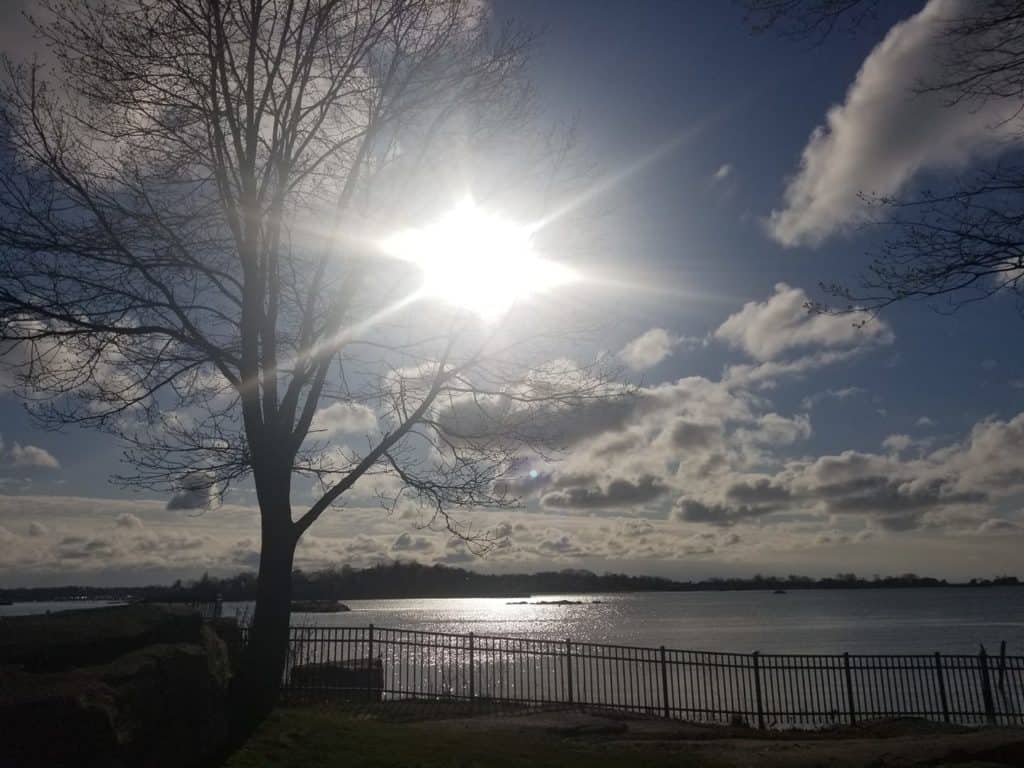
When my first daughter was born, a friend noted: “your capacity for grief has greatly and suddenly expanded.” And it had. The friendship, love, pride and the beauty of certain moments – whether or not we notice them in the moment -- are the fruits of our close relationships. As these treasures mount, so does the potential pain we will feel when suddenly that loved one is gone. As for me, I suppose my own capacity for grief has skyrocketed since that day – which also means there are more people (and a dog) in my life with whom I have strong and loving ties.

We observe mourning rituals because they are personally and culturally important and because we need a script to follow when we are in such unfamiliar territory. Those actions – funerals, wakes, shivahs, burials and unveilings -- represent our external, “public” expressions of loss.
We also have an internal experience, called grief. Unlike mourning, grief does not follow a timeline, or have an end date. Grief is often called a journey, and aptly so.
In one sense, we travel through grief as we experience its different stages, including the grief we start to feel even before the loss. Interestingly, the word “hospice” in medieval times referred to a way station for travelers . . . a place providing sanctuary for footsore and weary pilgrims.
Grief also feels like a constant companion – often a quiet one, sometimes disruptive, sometimes a comforting, and wholly unpredictable.
When my sister died I indeed paid the steep price of love. And I experienced grief as both the trip, and the companion. I have noticed the change in how I feel the pain, more a dull ache now than a sharp pain – and I have felt sad, even guilty and almost disloyal about that. That is the trip I am on.
I also have sudden realizations, like understanding that some of my memories were only shared between the two of us, that no one else would understand. Or that our common traits and quirks are now just mine. I think about how she would have handled pandemic times, what we would have decided about coloring our hair, and how we might talk about politics. Or I will stare at her photo and have a little conversation or a laugh. These make up the grief companion I travel with.
During this time of pandemic, the mourning and grief of the bereaved are layered with the tremendous emotional impact of current circumstances. Survivors of one who has died in isolation due to pandemic restrictions, may feel not only profound grief but also trauma from their loved-one’s rapid decline, their inability to comfort them, and not being with them as they died. Trauma is what happens in the brain when an individual experiences something that takes them beyond their normal emotional coping capacity. Experiencing trauma includes symptoms such as anxiety and flashbacks, and it interrupts the normal grief process.
I believe that many bereaved during these past months have, at best, a shaky foundation for moving through their grief. To those who feel unmoored and alone, I offer sincerest hope that they will find stability to start their journey, and happy memories to keep them company along the way.
The Bereavement Program at Connecticut Hospice is a resource for those bereaved who need grief support after the loss of a loved one under our care. It has become quite apparent that the grief that our bereaved are dealing with has been complicated by the COVID-19 pandemic. The fact is that many friends and family members, who were unable to visit their loved ones at all, due to the visitor restrictions for hospitals, nursing homes and assisted living facilities, had not seen their loved ones for months prior to admission to Connecticut Hospice in Branford. This has become part of the grieving process for many bereaved, unable to comfort their loved ones, or be the advocate at the bedside. The bereaved we are caring for are grieving what feels to be layers of emotion related to the unexpected crisis of the COVID pandemic in addition to the grief related to the death of their loved one. The Connecticut Hospice Bereavement Program continues to navigate this journey with the bereaved, providing comfort and support during a very difficult time, including group meetings. For more information, call Jennifer Stook, Director of Bereavement Services, at 203-315-7544 or visit www.hospice.com/bereavement-program.
Every September, the Connecticut Hospice community of patient families, friends, and caregivers gathers to celebrate and remember loved ones who passed away during the previous twelve months. Connecticut Hospice understands the special importance of this year's event (honoring patients lost 8/1/19 - 7/31/20) as a safe opportunity to gather while also providing closure for families and friends who might not otherwise have had the chance during this challenging year.
Connecticut Hospice is proud to invite you to its first live, virtual event. This event is not just for Ct Hospice families but for all those struggling with loss. Please share this event with anyone you think may benefit. Simply click on link below to bring you to our YouTube channel.
Ceremony of Remembrance Sunday, September 13th at 4 pm via our YouTube channel:
This link will also be available on our website @ www.hospice.com and Facebook page at https://www.facebook.com/CTHospice
https://www.cdc.gov/coronavirus/2019-ncov/daily-life-coping/stress-coping/grief-loss.html
https://www.psychologytoday.com/us/blog/supersurvivors/201909/the-power-rituals-heal-grief
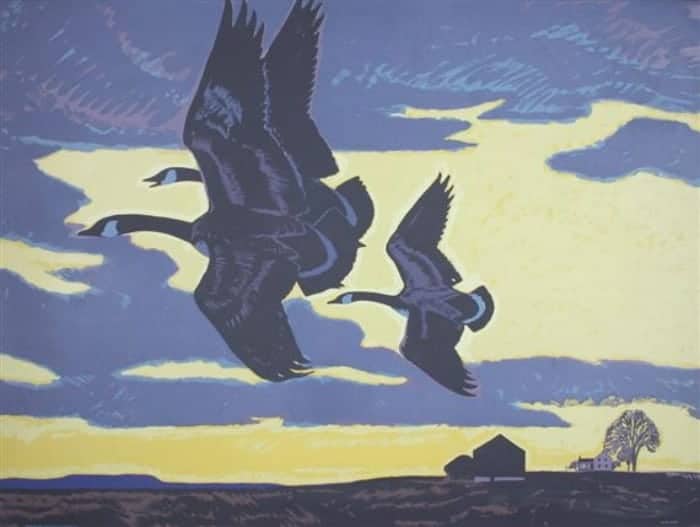
About an hour after my father died, I wandered away from my parents’ den, where he lay in a rented hospital bed, and went outside to be by myself for a while. On the horizon of the cold dusk sky the January sunset was a deep blazing red, more vivid than I remember seeing before or since. I imagined Dad shooting through the sky like a flaming arrow, for he was straight and true. Or like the Greek sun-god Helios arcing across the firmament in his chariot, for he was like the sun to me. Or Old Testament Prophet Elijah spiraling up to heaven in his fiery chariot, for Dad had (briefly) suffered, and deserved this final reward. Or all of these things at once.

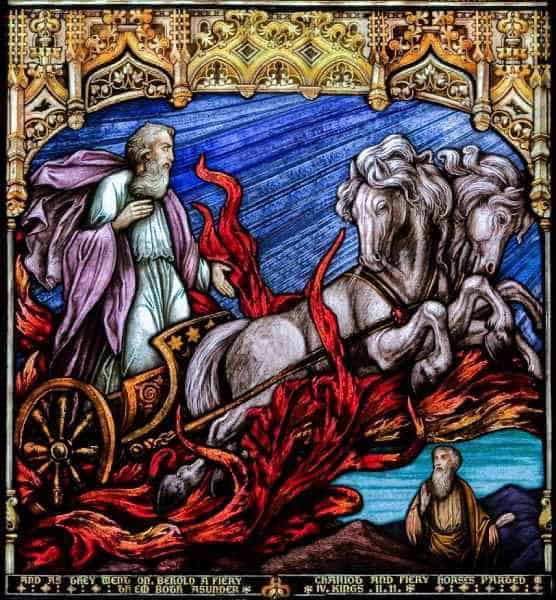
These images were felt by me instinctively, and I didn’t share them with my mother, my sister or my daughter - partly because they were so intense I didn’t feel I could speak them aloud, and partly because a little internal voice said that I might be perceived as being melodramatic or even superstitious. Dad was an atheist, besides, and an academic family such as ours generally needed provenance, logic, or science to believe such things, surely?
It turned out that we needed none of those things, and a few hours later any doubts I had of such ideas were firmly swept away. Sitting in the dark on the family porch, I was startled by a lone goose, who flew down unusually close to the house, only honking when right in front of me, and then flapped away. It felt like a visit, and I went inside to tell my family about this “amazing phenomenon” before returning outside to the still night air.
About half an hour later Mum came to join me, and literally as she stepped through the door, a chevron of geese swooped down lower than any ever had before, all honking wildly as they flapped by. This had to be a sign, right? Lo and behold, when my sister came out to look for us another half hour later, yet one more goose suddenly appeared out of nowhere to make its presence known.
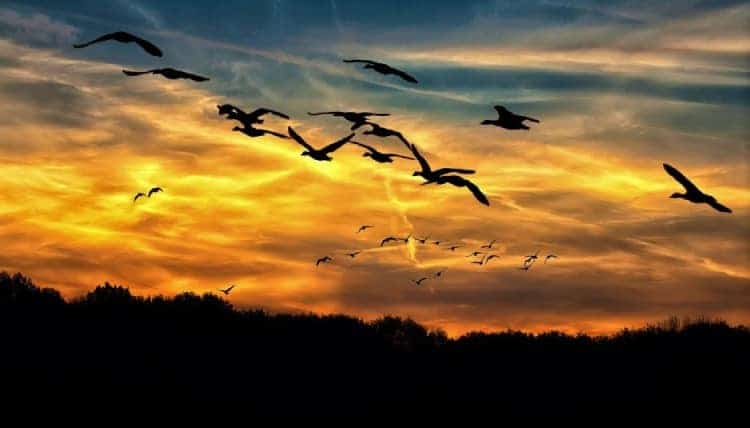
We all clung to the belief that this had to mean something, because believing the geese were visiting for a reason, that they might even be Dad saying goodbye, brought us comfort in that bleak “dark night of the soul”.
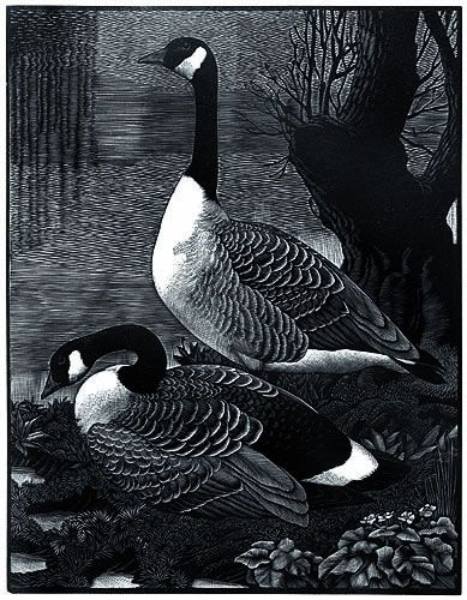
Since then, half the birds of the northern hemisphere’s skies have become ‘symbols of Dad’, such is our wish to remain connected to him in as many ways as possible. My sister and I have talked about this – she lives thousands of miles away, on another continent, and yet she sees the same ‘signs’.

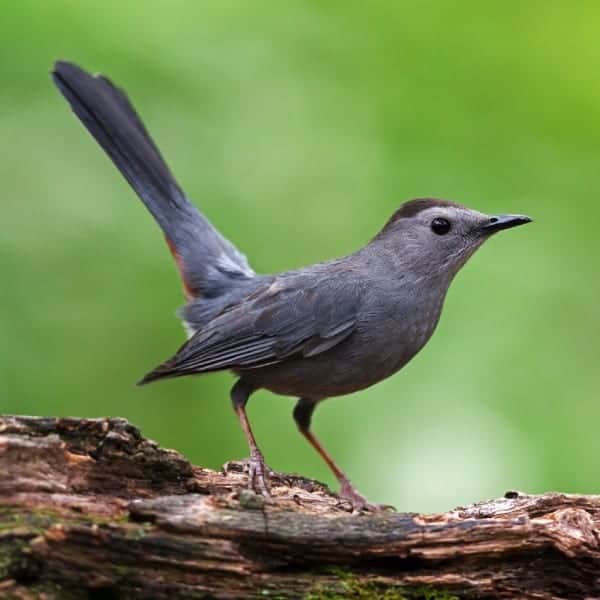


For me, noble hawks always seem to circle overhead when I need his strength;
bright, persistent cardinals pop up in the nearby hedgerow when I want to chat to him;
mated-for-life swans scud silently by to remind me of his marriage proposal to my mother on the second day they met (married five weeks later, they were soul mates for 60 years);
never-shy catbirds hop right up close and train their beady eye on me in the same piercing way Dad always did;
squabbling blue jays even bring back family silliness, when we were a family together;
ephemeral, iridescent hummingbirds are rare and colorful visitors to my yard, but he was rare and colorful too.
And the seminally symbolic geese always bring me right back to the seismic shift in our world on that evening, when at one moment he was alive with us and in the next he had wrenched himself away.
Accepting and allowing that he was gone, in intensely painful slow motion, was like a long difficult labor, delivering a new reality.
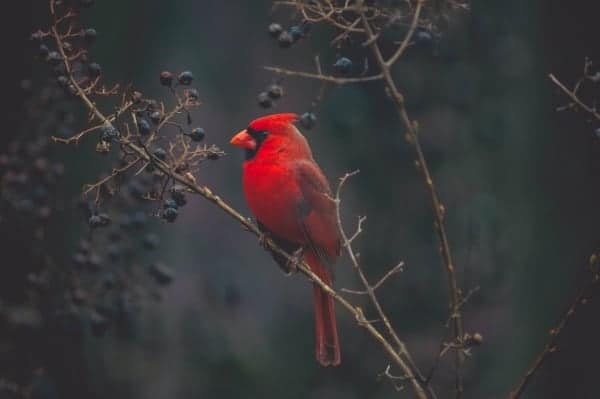


Why do human beings believe that signs and symbols from the natural world represent the presence of, or messages from, our loved ones after they are gone? For instance, many people believe that butterflies are deep and powerful representations of life. Butterflies are often thought to be a symbol of their departed loved ones or of eternal life, perhaps because of their metamorphosis from chrysalis to butterfly. Recently, Dmitri, a Connecticut Hospice staff member’s son, felt it was symbolic to release the 6 new butterflies from his Butterfly Garden on the site where hospice care first began in the United States.
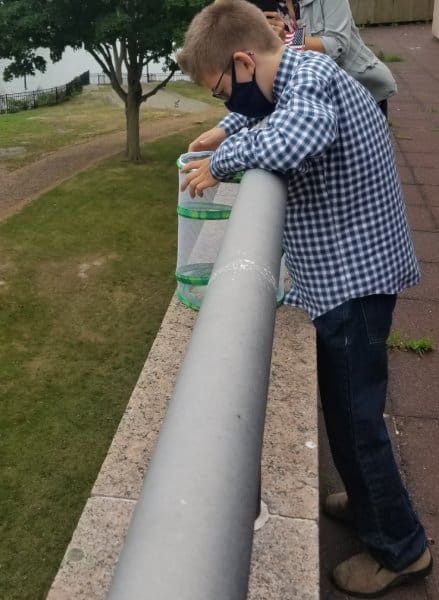
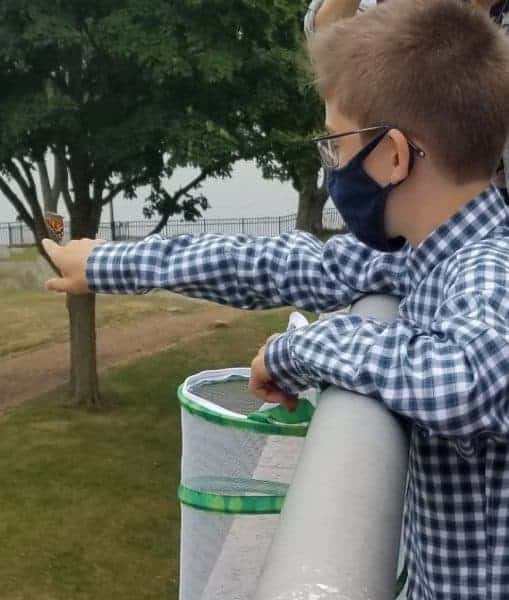
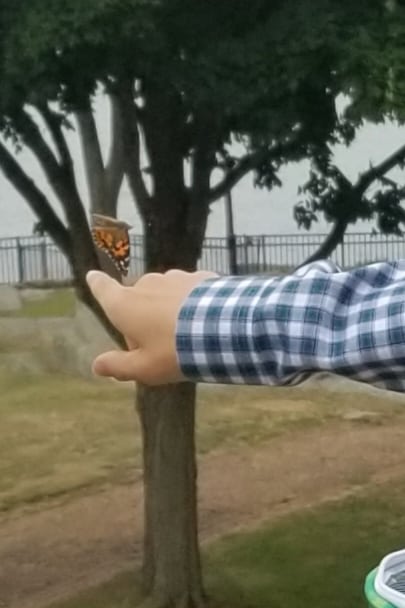
Dragonflies are said to symbolize change and transformation, and are connected to signs from loved ones. Feathers, storms and rainbows are also often imbued with special meaning after a loss.
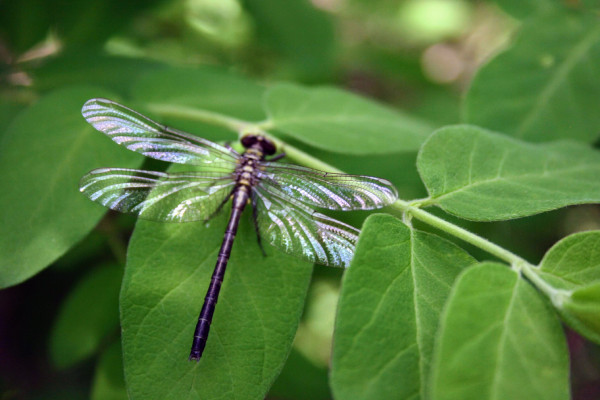


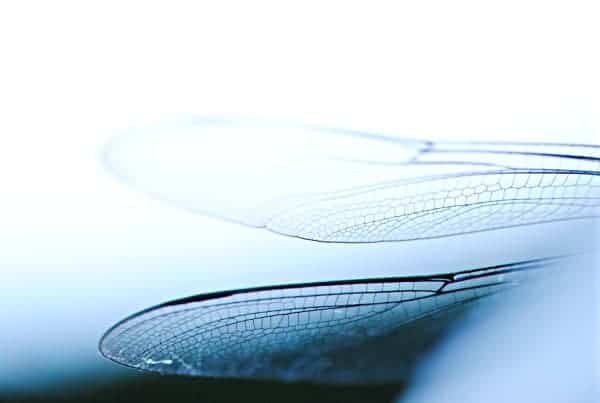
There are websites devoted to supporting the bereaved through the sharing of personal stories of ‘signs and symbols’ they have experienced. Click here for an example: signs of a deceased loved one
People often tell the recently bereaved to “look for signs – you’ll see them all around”, to reassure and comfort, and because they believe it to be true.
It seems that we try to hold onto someone we dearly miss by creating a physical manifestation where there is no longer a physical presence. That so many of these ‘messengers’ are animate entities of the natural world – animals, birds, insects, sometimes even flowers and trees – appears to bear this out.
It is well documented that nature has the power to bring solace and rejuvenation to us whether or not we are grieving, and it is plausible that we instinctively understand this capacity when we so readily ascribe special meaning to its creatures and its beauties.
Nick Cave writes
“The paradoxical effect of losing a loved one is that their sudden absence can become a feverish comment on that which remains. That which remains rises in time from the dark with a burning physicality — a luminous super-presence — as we acquaint ourselves with this new and different world. In loss things – both animate and inanimate – take on an added intensity and meaning”.
Nowadays, when Mum and I sit on the porch together, we sometimes talk about the ‘Great Creative Force” that connects all things. As an artist and woman of great wisdom, my mother can find symbolism and interconnection everywhere. Where once the anecdotes we heard about ‘signs’ from departed loved ones were possibly feasible, but mostly abstract, ideas, our family now knows and feels the truth of them.
We lost him but now he is everywhere.
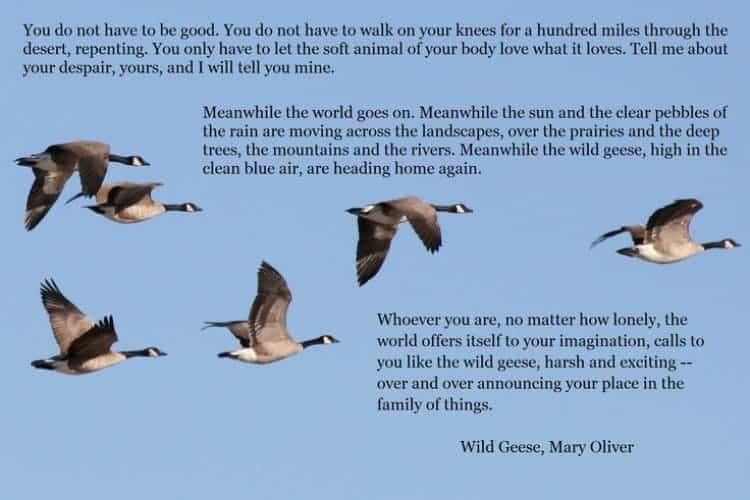
Further resources:
To read Nick Cave's entire piece, click here: how to understand the experience of loss
To read an essay on birds and loss, visit: the birds scattering blue
What is the 'dark night of the soul'? To explore its interpretations, click here: the dark night of the soul - understanding amidst the absence of meaning
To hear the exquisitely beautiful "Dark Night of the Soul", Ola Gjeilo's composition for chamber choir, piano and string quartet (approx. 13 minutes), watch: Youtube: Dark Night of the Soul, Ola Gjeilo
Learn about and listen to catbird songs: All About Birds: Gray catbird sounds
All about Helios and how he is different from Apollo: Wikipedia: Helios
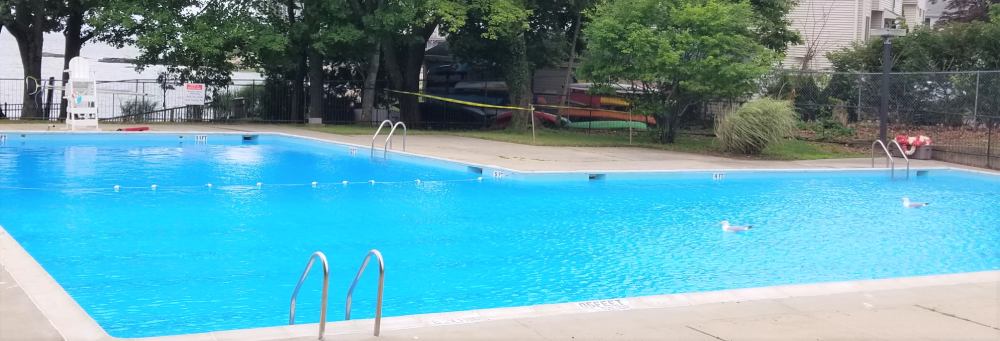
Connecticut Hospice is pleased to join forces once again with Branford Parks and Recreation Department to offer the Hospice Pool Program.
Socially distanced swimming is easy when our pool is Olympic-sized, and numbers are kept low.
Add beautiful views of Long Island Sound and ample free parking, and there's no reason not to join us.
Options include; Open Swim, Aquacise Classes, and Senior Swim.
For eligibility and details, please visit: Branford Parks & Recreation Hospice Pool Program

Hospice Caregivers are daily in the presence of people who are in need of support and comfort, whether they are a patient whose illness is causing them physical suffering or emotional angst, or they are a family member in grief for the imminent or recent loss of someone they love.
In the previous two installments of our series on Spiritual Care in Difficult Times, Connecticut Hospice Pastoral Care Volunteers explored the role they play for people feeling the pain of fear, anger or hopelessness, or for those wishing to focus on their spiritual strength, regardless of whether there is a connection to any particular faith or not. They spoke of the profound spiritual connection that can happen when they sit in silence and solidarity with another human being,.
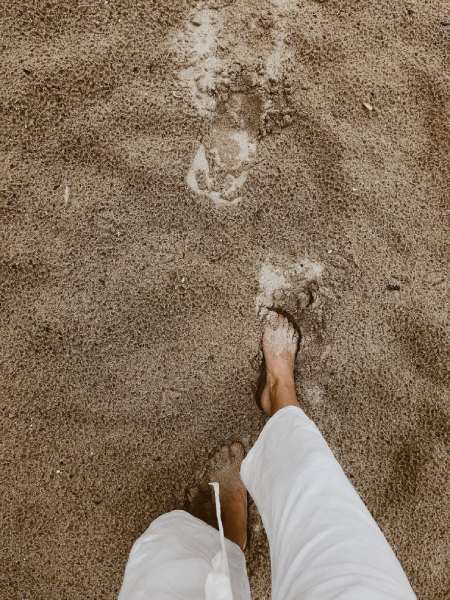
In this third part of the series, Allison H. Fresher, Pastoral Care Volunteer at Connecticut Hospice, shares a contemplative piece about accompanying those in hardship and pain, and reports of the joy, emotional healing and opening of hearts that can come from human togetherness.

Come walk with me. We will walk along the beach together. I know there is a storm brewing this day. After all, this is the rainy season. Big, puffy clouds, filled with rain, sit heavily over our heads, unmoving, almost black. Our feet shift in the sand. Today, the water does not glisten nor reflect the sun’s rays. Rather, we see signs of the coming storm.


The tide is going out, the Sound’s whitecapped waters flowing towards the larger sea. I notice a puffy, white, ocean bird floating by us. I let go of your hand, so I can point it out to you. How amazing, I think. It rides the current, not fighting the water’s forceful flow. It seems almost joyful or certainly, at peace with the water’s chaos.


You turn your head and look. Now, we are both staring in the same direction. We join our hands again, holding them tightly. Together, we stand there, captivated.
God grant me the serenity
To accept the things I cannot change;
Courage to change the things I can;
And wisdom to know the difference.
Living one day at a time;
Enjoying one moment at a time;
Accepting hardships as the pathway to peace*
*These lines excerpted from the Serenity Prayer, written by Reinhold Neibuhr in the 1940's
In acceptance, we find peace. In times of hardship, joined together, unexpected gifts captivate us. Joy can arise from sorrow. We may smile with fond memories or feel strengthened through forgiveness, given or received. Through our pain, spirituality may be discovered or reborn. In times of trial, these outcomes can happen; they often do happen. Yet, there may also be doubt.
When I enter a patient’s room, I sometimes perceive a patient or family member erecting an invisible wall. Due to real world experiences, some may fear that I will attempt to preach over their doubt, convert them to a particular faith tradition, or proselytize. Others may believe that, since we walked different paths in life, we cannot relate. I have had many of these same feelings, and so, I empathize.

As pastoral care providers, we respect difference and acknowledge doubt.
Answers to the hardest questions are elusive; as humans, simply put, there are mysteries.
Healing takes time, and acceptance can be hard won.
At Connecticut Hospice, we experience with our patients, their families, and even staff members, the broad range of emotions arising from pain.
Sometimes, we are the students, and our wonderful patients are the teachers.
Other times, we help those in need find their way to healing, faith and hope.
Either way, the most perfect gift is exchanged.
Our hearts are opened.

We are here to take the walk with you, looking out at the stormy sea together. Know this; in our humanness, even while in the worst pain, there is a path to acceptance and joy. At Connecticut Hospice, it has been a privilege to witness this powerful journey, over and over again.
The sun does come out, and the light again shines.

Further resources suggested by Allison:
https://tinybuddha.com provides simple wisdom for complex lives.
https://www.beliefnet.com helps people find and walk a spiritual path that instills comfort, hope, strength and happiness.
http://www.contemplativeoutreach.org provides resources in support of contemplative prayer, bringing calm and stillness to a hectic world.
In addition, readers should be encouraged to reach-out to the Connecticut Hospice Pastoral Care Department for helpful prayer resources aligned to each faith background:– 203-315-7512.
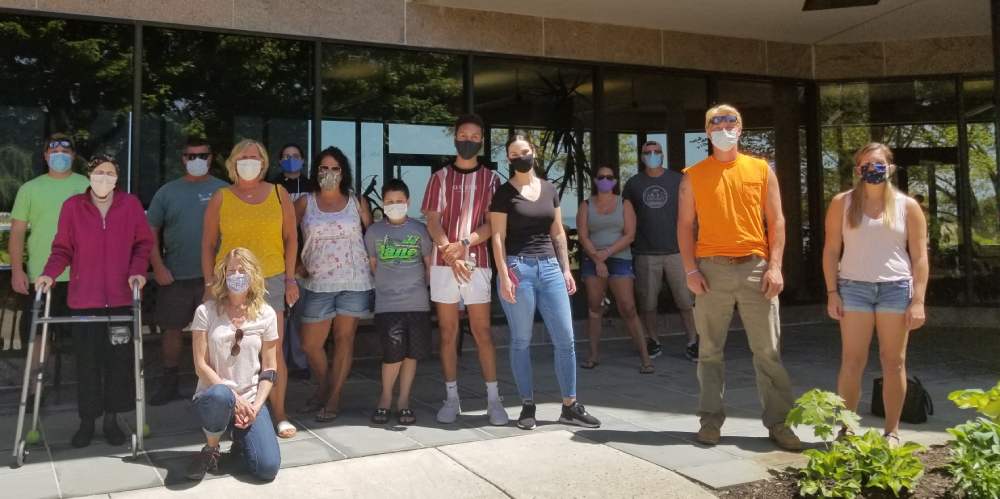
One of hospice care’s fundamental principles is to provide support not only to patients but also to their families. Until May 20, Mrs. Bachman was the patient in the Bachman family, fighting pancreatic cancer.
On May 21st that all changed and Mrs. Bachman was suddenly to become the family member, and soon a widow. On that day her husband unexpectedly collapsed and was rushed to YNHH where his condition was diagnosed as terminal.
On May 22 Mr. Bachman was referred to Connecticut Hospice. When he arrived at the inpatient facility, unfortunately state visiting policies during COVID-19 could only allow two visitors, his wife and daughter, to be with him in person.
The entire family gathered in front of the Connecticut Hospice facility hoping for a glimpse of the husband, father, father-in-law, grandfather, and great grandfather they hadn’t seen since his collapse, and probably would never see again.
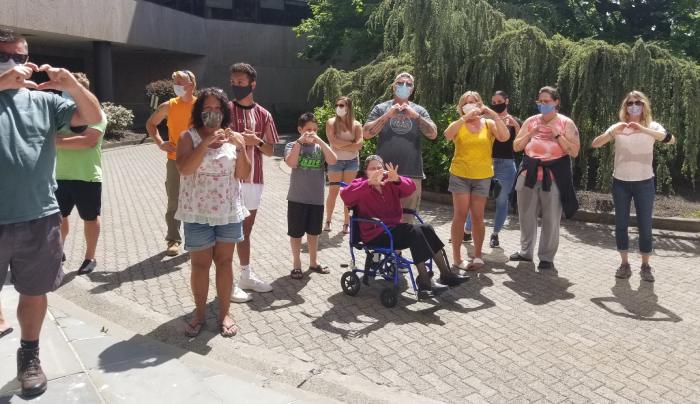
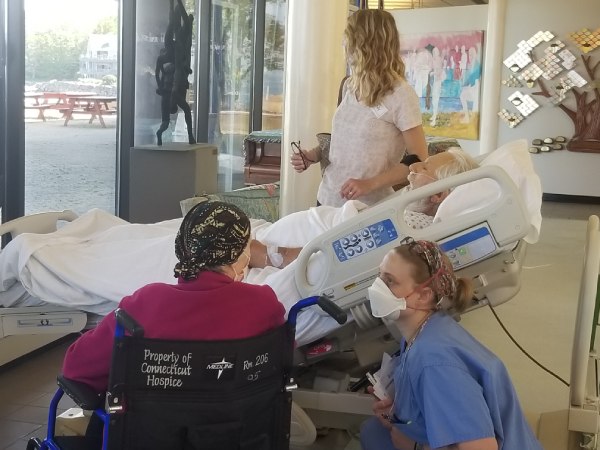
As the ambulance arrived, the family gathered closer to voice how much they loved him and made heart shapes with their hands.
Staff Social Worker Stephanie Albright met with the family outside and realized how close Mr. Bachman was to the end of his life, and how important it was that this family got to see their loved one for one last time. She quickly contacted the nursing staff and coordinated a last-minute window visit.
Mr. Bachman was wheeled down to the window in the lobby, while outside his family stood, choking back tears but smiling with love.
They all raised their hands as one to make an "I Love You" sign, and sent him a final outpouring of love by singing one of his favorite songs to him: “Country Roads,” by John Denver. All the generations of Bachmans singing together to their loved one was amazing and profoundly moving to witness.

Since Mr. Bachman’s death, this large multi-generational family (4 adult children and spouses, 17 grandkids and 2 great grandkids) has come together to support each other in their sorrow, spending many days together working through the unexpected loss and sharing memories, meals, stories and grief.
They have also graciously allowed us to share their Connecticut Hospice experience with you.
This close, loving family has made an impression on our staff, but one member in particular has stood out from his adult relatives, not only because of his age, but for the words he spoke when sharing memories of his “Papa”. 8-year old great-grandson Jayden was asked how he would describe his Papa, and his answers are a testament to the deep connection shared by patients and families, and why treating the patient and family as one is of such importance.
“He put everyone else first, especially GG.”.
“He was kind.” “Papa was always respectful of everyone.”
“I know when he comes to visit it is his soul talking to mine.”
“When I see a heart, I know it is him.”
“I talk to him and tell him I hope he is happy and that I miss him.”
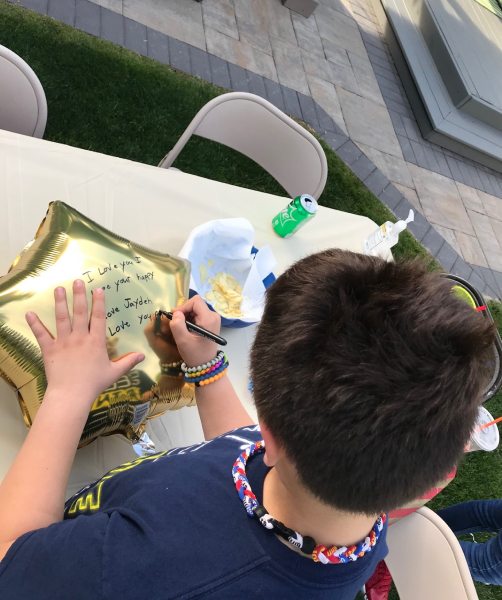
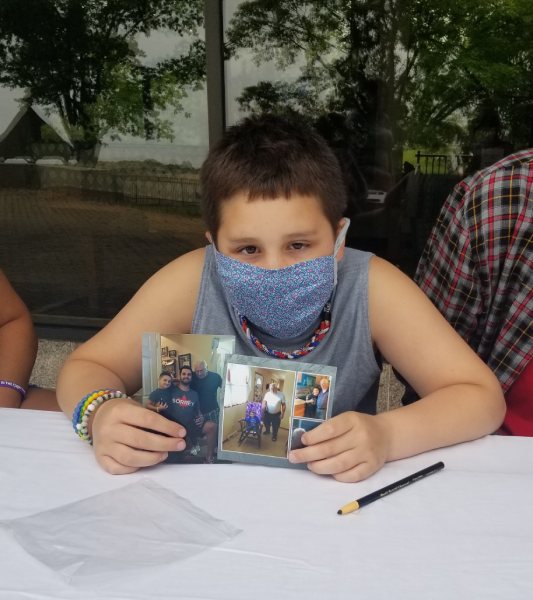
Connecticut Hospice Resources
Read more about the patient and family as one unit of care here Patients and Caregivers
For information on grief support click here: Bereavement Program
On Children and Grief
Hospice Foundation of America: Children and Grief
The Dougy Center/The National Center for Grieving Children and Families: How to Help a Grieving Child
Psychcentral: Children and Grief
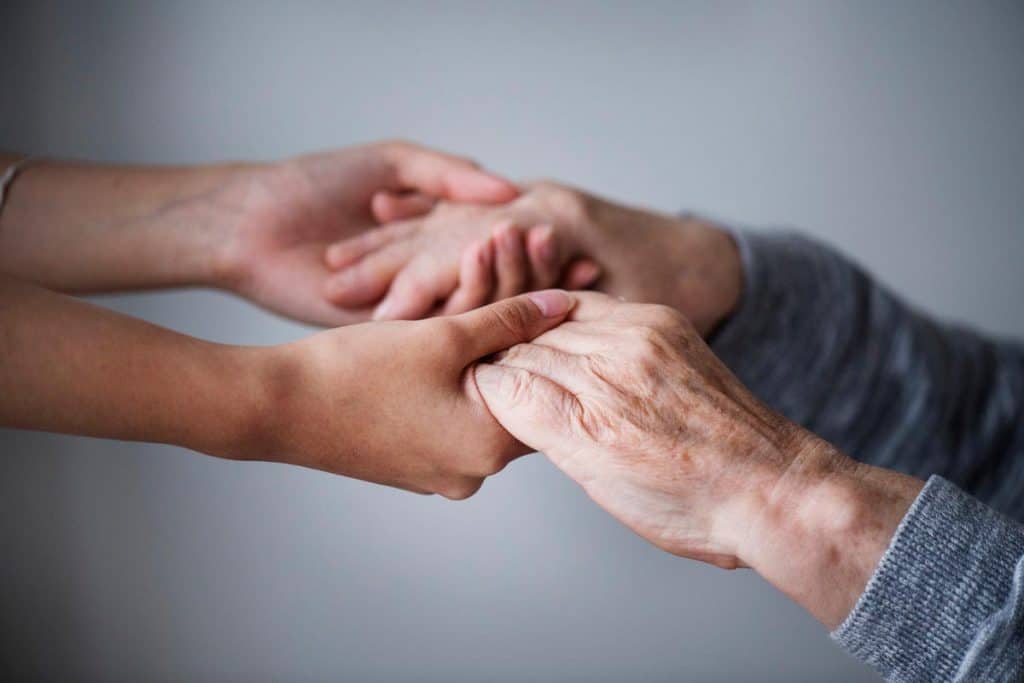
NPR's Life Kit always features many useful resources, but we couldn't agree more with the timeliness and importance of their recent offering "End-of-Life Planning is a "Lifetime Gift" to Your Loved Ones".
Author Kavitha Cardoza points out how difficult it is for many people to talk about, and plan for, death.
"That's a big mistake, because if you don't have an end-of-life plan, your state's laws decide who gets everything you own. A doctor you've never met could decide how you spend your last moments, and your loved ones could be saddled with untangling an expensive legal mess after you die".
Cardoza presents a list of six tasks with input and detail from additional experts. The recommendations are offered not only to make the end of your life smoother, more manageable, and adherent to your own choices, but also to make the process and the time after you are gone much easier for your loved ones to navigate.
Her recommendations are in no way offered as legal or medical advice, but are presented in simple steps to get you started.
To read the article, or listen to the audio, click here: NPR Life Kit: End-of-Life Planning is a "Lifetime Gift" to your Loved Ones
As a not-for-profit, we depend on generous donors to help us provide customized services and therapies that aren’t completely covered by Medicaid, Medicare, or private insurance.
Please make a gift to help us sustain the highest standard of care.
Admissions may be scheduled seven days a week.
Call our Centralized Intake Department: (203) 315-7540.